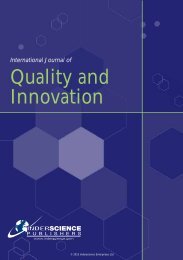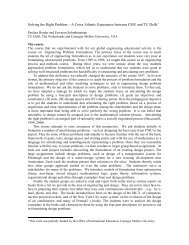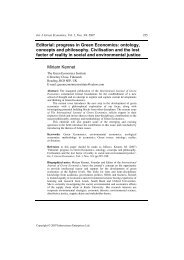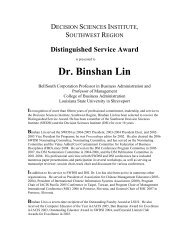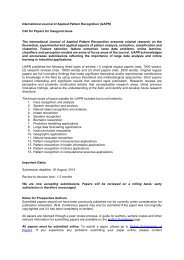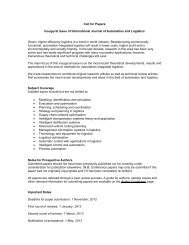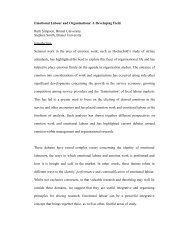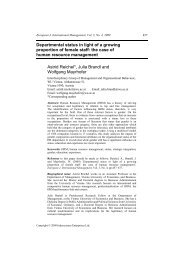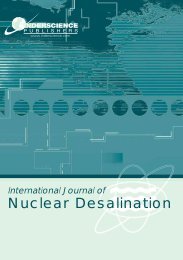A new Zeitgeist for international business activity and ... - InderScience
A new Zeitgeist for international business activity and ... - InderScience
A new Zeitgeist for international business activity and ... - InderScience
You also want an ePaper? Increase the reach of your titles
YUMPU automatically turns print PDFs into web optimized ePapers that Google loves.
290 J.H. Dunning<br />
influence the access, creation <strong>and</strong> deployment of the RSMs under the governance of<br />
private <strong>and</strong> public wealth creating entities. Foremost of these are changing ingredients of<br />
the intention of firms in an unpredictable <strong>and</strong> volatile global environment; the recognition<br />
of the importance of their incentive structures <strong>and</strong> fostering their relational assets; the<br />
advantages of operating in multiple institutional environments (Xu <strong>and</strong> Shenkar, 2002);<br />
a focus on minimising the systemic costs of MNE <strong>activity</strong>; <strong>and</strong> a reappraisal of the nature<br />
of entrepreneurship in decision taking (Korine <strong>and</strong> Gomez, 2002). 7 To countries, the <strong>new</strong><br />
<strong>Zeitgeist</strong> of HR is directed towards upgrading both their domestic macro <strong>and</strong> micro<br />
institutional assets, <strong>and</strong> to reducing cross-border institutional distance. In the case of<br />
supranational entities, institutional values <strong>and</strong> systems including those of the dominant<br />
personalities within the organisations can be quite critical (Stiglitz, 2002). Both James<br />
Wolfenson of the World Bank <strong>and</strong> Kofi Annan of the UN have, by inculcating their own<br />
particular values <strong>and</strong> ideologies, effected major change in the institutional profiles of<br />
their respective organisations, notably towards poverty alleviation <strong>and</strong> human rights.<br />
What then is the empirical evidence about the <strong>new</strong> <strong>Zeitgeist</strong> of the H&PEs in IB<br />
<strong>activity</strong>? The answer is very little – primarily because the ‘<strong>new</strong> spirit’ is in its early<br />
stages. Here we would repeat an observation made earlier – that while economists are<br />
now fully engaged in evaluating the role of institutions as a determinant of economic<br />
growth, there is little evidence that, with two exceptions to be identified in the next<br />
paragraph, mainstream IB scholars are doing the same as far as the evolutionary path or<br />
prosperity of firms is concerned. This, in no way under-values the contribution of<br />
scholars researching into culture <strong>and</strong> human resource management. Quite the reverse.<br />
Indeed, we believe this contribution should be better acknowledged, <strong>and</strong> be given a more<br />
prominent position in mainstream economic, management <strong>and</strong> organisational studies.<br />
Turning to the two exceptions, the first refers to the work of internalisation scholars, 8<br />
whose main attention, since the time of Coase (1937, 1992), 9 has been directed to<br />
explaining the mode of exploiting the RCMs of MNEs. However, even here, not only are<br />
the choices assumed to be rational <strong>and</strong> deterministic, but little attention is paid to how the<br />
content of each of the modes is perceived. The second exception is a growing<br />
appreciation by strategic management scholars of the need to better integrate the resource<br />
based view of the firm with that of institutional theory (Oliver, 1997; Peng, 2001;<br />
Lu, 2006). Lu in particular argues <strong>for</strong> a co-evolution framework of institutional<br />
relatedness <strong>and</strong> strategic assets to explain the scope <strong>and</strong> per<strong>for</strong>mance of firms.<br />
A cursory review of the literature suggests that, up to now, most scholarly empirical<br />
research has focused on how the content <strong>and</strong> quality of the institutions of countries have<br />
affected the locational decisions of inward <strong>for</strong>eign investors. The answer is quite a lot,<br />
particularly in the case of the transition economies, <strong>and</strong> in respect of the quality <strong>and</strong><br />
effectiveness of its democratic institutions, property rights legislation <strong>and</strong> innovating<br />
systems (Grosse <strong>and</strong> Trevino, 2005; Grosse, 2005; Jensen, 2006; Dunning, 2007). 10<br />
But there have been only sporadic attempts to evaluate the importance of country specific<br />
institutional assets as a competitive advantage <strong>for</strong> firms, although recent work by IB<br />
scholars on institutional relatedness <strong>and</strong> corporate diversification is throwing up some<br />
interesting propositions. Neither do we know much about which institutional assets are<br />
most likely to affect the modality of exploiting or accessing the ownership specific<br />
advantages of firms in their decisions of what, <strong>and</strong> where, to produce.



